Recollection: a personal view
Is ten years ago “history”? To me it is the recent past. In a sense it’s the extended present; it is still with me. Just like the majority of the books of my library I then had, the Japanese porcelain cup of my morning coffee, even the car that I drive. 3.11 is history. San ten ichi ichi – as the date 3.11 is pronounced in Japanese, literally “three dot one one” – refers to 11th March 2011. In Japan this quickly became a fixed expression and everyone knows what it means, shorthand for the Great Eastern Japan Earthquake, the official name of this event.
3.11 was a major natural disaster aggravated by the meltdown in the nuclear power plant Fukushima I, because of which it received world-wide media coverage. Within days, foreign correspondents were experts in nuclear technology and directed their attention largely to this aspect of the catastrophe. The international press thus transformed “Fukushima” into a code word for nuclear accident; especially in Germany, where the anti-nuclear movement is strong. It became a standard joke at the time that “Fukushima” affected just two countries, Japan and Germany.
Such a way of looking at 3.11 in no way reflects how we experienced the magnitude-9.0 quake and tsunami that immediately killed thousands of people, while nobody died in or around the nuclear power plant. Although we were living some 370 kilometres from the epicentre of the quake, it shook us to the bone. Like everybody who lives in Japan, we had felt and lived through countless earthquakes, but nothing even remotely resembling the tremors that made everything around us and the floor under our feet shake for an unimaginably long six minutes. On average, strong earthquakes last 20 or 30 seconds. Six minutes, that was like the end of the world. I still have the picture of my daughter’s SMS message on my mobile asking me if I was alive (fig. 1). It was meant seriously. Shortly after I had received her message to my great relief – because it told me that she was alive – the network collapsed, as did all local transport in Tokyo. After evacuating the institute and sending everyone home, I walked home too, some 20 kilometres through an eerily quiet city under serene blue skies.

Our shock experience was nothing compared to what happened to the people living along the coast of north-eastern Japan: hundreds of kilometres of total devastation (fig. 2), thousands of people dead or missing, and many tens of thousands left homeless. It wasn’t out of curiosity, but a sense of “couldn’t we do anything?” that made us drive up some 500 kilometres to the disaster area. We packed supplies provided by an NGO into the car and drove up north to deliver them to an NGO in Kesennuma, a port town in Miyagi prefecture which had lost the better part of its fishing fleet (fig. 3).
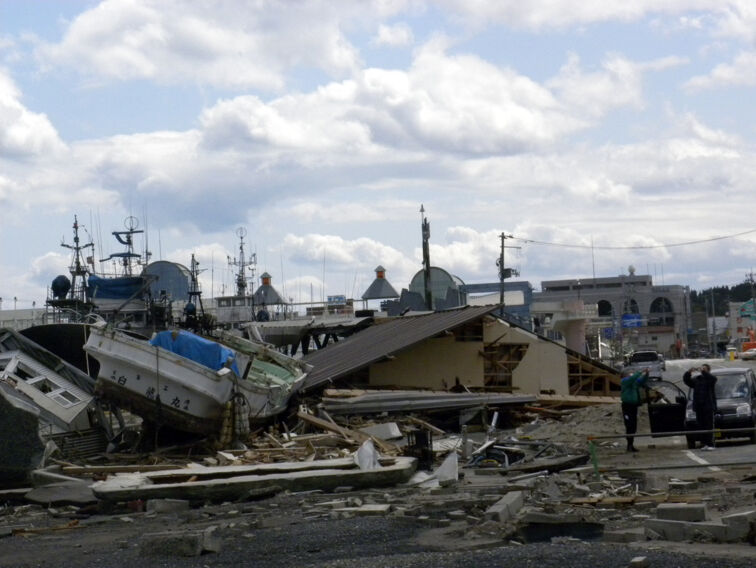
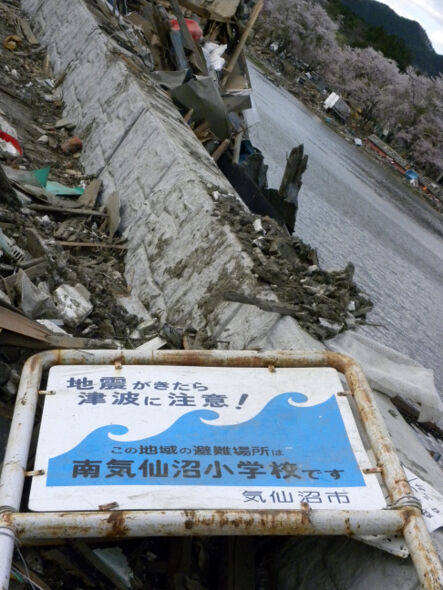
After our return to Tokyo we, Judith Stalpers and I, decided to write a book about the disaster, because the misery we had witnessed did not shine through the press coverage [Coulmas and Stalpers 2011]. Judith had been in Fukushima before. As a journalist for technology periodicals, she had actually been inside the power plant in Fukushima and, in contradistinction to many other foreign correspondents, knew what a nuclear reactor was. On my part, I could contribute some observations about how the residents of the disaster area and beyond reacted to the catastrophe, because Japanese society is my academic field of research.
A freak event or an incentive for change?
We were living in Tokyo before 3.11 and for another four years thereafter. Did the disaster change our life? Was there a new beginning subsequently? This question is surely more interesting regarding Japan as a country than a few individuals. Yet, without undue generalisations, individual viewpoints can be instructive.
I have two photographs I took shortly after 3.11 (figs. 4-5). One shows a cemetery with toppled-over gravestones, a frightful measure of most devastating earthquakes; the other one is of a simple poster outside a 24 hour-store featuring a message of encouragement: “Give your best, Fukushima! Put a smile on every face! Vigorously, Japan!”. It took just days to print such posters and put them up in the face of utter destruction all around.
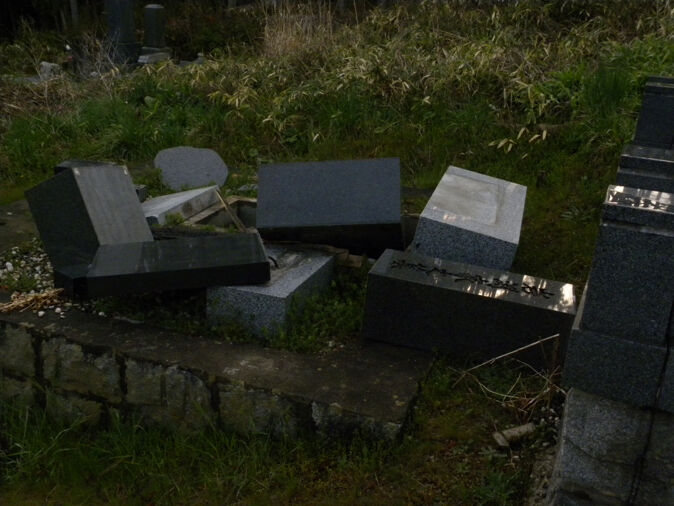
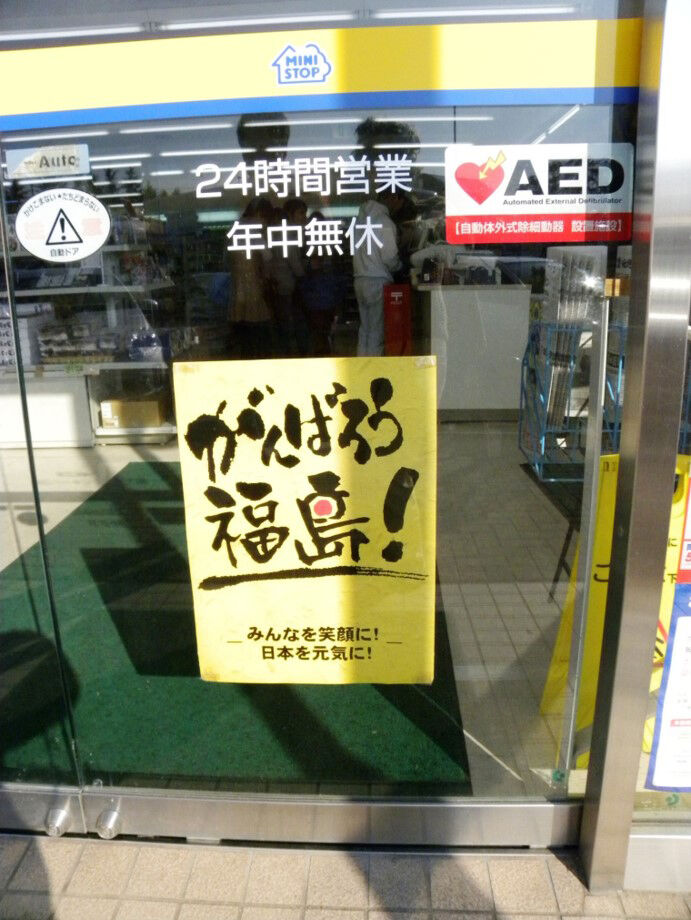
Japan is a country visited by natural disaster so frequently that everyone remembers the last time it happened and is, therefore, aware of the superior powers of nature. If there is such a thing as national character, it can be said that the tectonic and climate setting of the Japanese archipelago has imbued its inhabitants with a rather fatalistic outlook on life. Disasters happen. If you survive, get back on your feet and do your best! Let’s help each other to overcome the calamity!
Social relations are the only protection against the consequences. Accordingly, solidarity is highly valued in Japanese society and invariably stressed in case of disaster. Yes, 3.11 was extraordinary in magnitude, but – in a sense – nothing new. The order of the day was continuity and resilience rather than a revolutionary new beginning.
Relief measures
People made homeless by the disaster needed immediate support; there was no time to consider various options for relief. Whatever emergency plans existed, had to be implemented without delay supplemented by various impromptu arrangements. The tasks for local, prefectural and national administrations were huge. To mention just one figure, according to the Reconstruction Agency of the Japanese government, an estimated 320,000 victims had to be provided with makeshift housing in tents, containers, etc.. When the agency was established in 2012, it was clear that helping the hardest hit prefectures Fukushima, Miyagi and Iwate to get back to normal life was a long-term project, for which an initial time frame of ten years was set. For the first five years of intensive reconstruction, the government allocated 25 trillion yen (approximately € 203 billion). By March 2021, 32 trillion yen will have been spent on 3.11 reconstruction programmes.
Much remains to be done, and it was decided to keep the Reconstruction Agency through fiscal 2030, though with a lower budget. Not all scars are healed, not all graves have been closed yet. The official death toll stands at 15,899, while 2,529 persons are still unaccounted for, but not likely ever to be found.
Almost 800 people continue to live in prefabricated housing. In addition to those whose homes collapsed or were washed away by the tsunami, many people living near the Fukushima I nuclear power plant had to leave their homes because of unsafe levels of radiation. At the peak of the crisis there were some 470,000 evacuees. Their figure has been reduced over the years and now stands at some 47,000. Most of them fled their homes once it had been ascertained that a meltdown had occurred at Fukushima I. Many of them found refuge from the danger of radiation with relatives and friends spread across the country and are unlikely to return to their former homes. This is true in particular of younger people, who found work and whose children have gone to school for almost a decade elsewhere. What is more, no-entry zones in Fukushima prefecture are still in force, with no government plans in sight to lift the ban.
Looking at the population figures and at the spatial extent of the affected area, it is obvious that Fukushima, Iwate and Miyagi are, luckily, among the least densely populated prefectures of the country, which brings in another variable to our considerations about recovery and new beginnings: demographics.
Japan is a hyper-aged country with a shrinking population [Coulmas 2008]. Rural prefectures – in particular – experience significant population decline, to the extent that questions were raised about whether the funds for reconstructing the infrastructure were well spent. Since 3.11, some 350.000 people moved away from the three prefectures. Compared to the 30 million of greater Tokyo, that’s a drop in the bucket, but it amounts to 14 per cent of the three prefectures’ combined population. Young people move away in search of work, while the elderly remain, further aggravating the precarious population structure. The Joban railway line, which connects 85 stations on a 368 kilometres track along the Pacific coast, was rebuilt at great expense and at long last fully reopened in March 2020. But who for, some people ask. Other expensive infrastructure projects, roads, dams and elevating land to protect new houses from future tsunamis were also completed, according to plan. Yet there are doubts that they will be able to halt the population exodus.
These and similar observations confirm what disaster relief organisations like the Red Cross have known for a long time, namely that such occurrences have immediate and long-term consequences. The latter, such as population dynamics, can be highly complex and hard to take into account for emergency planning. The two nuclear power plants in Fukushima prefecture were built to produce electricity not for local consumption, but for Tokyo; however, one doesn’t put nuclear power plants in densely populated areas. They were built in Fukushima because of the small population. In hindsight this was a good thing, since in a more densely populated area many more people would have been affected, but the disaster turned things on the head. The population decline in Fukushima prefecture accelerates because of 3.11.
1.10
January 10th is another iconic date, at least for some people of my generation. On this day, in 2019, I had the privilege to attend the commemoration of an event fifty years back, storicamente, at the University of Tokyo. It was a gathering organised by student activists of the 1968 movement. On that day, in 1969, they occupied the university’s central building, Yasuda Auditorium, with barricades and all and thus brought the university to a standstill for days on end. What has happened since, several of the activists – aged by a half century – asked themselves and asked the public. Many of them took to the lectern of the big auditorium.
They were all men. In the entire hall, which was packed with about 150 people, it was hard to spot two or three women. History. Japanese student protests in the ’60s were led by men.
Demonstrations against the visit in Japan of the nuclear-powered USS Enterprise before going on to Vietnam; protests against the Japanese government’s collusion with the United States’ war in Vietnam. Napalm and Agent Orange came to mind as insignia of the student movement in Europe, too.
Some of the speakers recounted what they experienced at the time, others tried to make sense of how the students dared to challenge the authority of Japan’s most prestigious university and the Japanese government with it. Some of them addressed the audience as agitated and fiery as once upon a time. It wasn’t a current event that unfolded in front of me, but history (fig. 6).
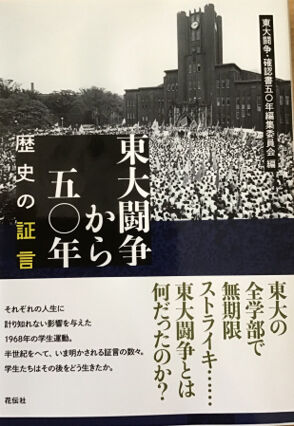
Although it was fascinating to listen to the testimonies of those who took part in the occupation of Yasuda Auditorium, the most interesting contributions came from speakers who devoted themselves less to the past than to the present. “Where are the students today?” they asked. “How complacent can they be?!”. “What happened really on 3.11?”. “The University of Tokyo, the spearhead of Japan’s intellectual élite, acted as a mouthpiece for the government! Isn’t that a shame?!”. Voice raised, hands in the air, genuine indignation. Many of the listeners nodded in agreement.
What this speaker alluded to was the fact that nuclear physicists and technology experts of the University of Tokyo did not contradict or correct the Japanese government’s very restrictive information policy following 3.11. While scholars overseas immediately began discussing the possibilities and consequences of a meltdown at Fukushima I, the government held back – for fear of causing a panic and because of a general communication policy – to release but confirmed facts in official statements rather than conjectures. By and large, the nuclear experts of the University of Tokyo followed this line, to the consternation of the 1968 activists.
Organisational structures
As can be expected in a disaster of this dimension, and as a look at the details reveals, the situation was highly complex. Suffice one example to illustrate. On 12th March 2011, as the situation on the ground of the power plant became ever more perilous, the question came up whether seawater could be pumped into the plant for urgently needed cooling. Who was to decide? What was the chain of command? Far away from the scene in Tokyo, the Prime Minister’s office and the CEO’s office of Tepco, the company owning and running Fukushima I, held crisis meetings to tackle the issue, but in both meetings no nuclear scientists were present. Contradictory orders were sent from Tokyo to the power plant, and eventually its director Masao Yoshida had seawater introduced into the reactor to cool it, ignoring prescribed steps of the decision making. For a Japanese company this was nothing short of scandalous, but – by acting independently – he probably saved lives.
This episode and a succession of others connected with the nuclear accident gave rise to the question if Japanese organizational structures were up to the challenges posed by major disasters. Thanks to a horizontal structure that involves many people concerned rather than a vertical top-down line of command, Japanese companies and institutions tend to be slow but very effective. Could 3.11 prompt a rethinking of this pattern? One of Japan’s best know economists, the late Masahiko Aoki, who incidentally was active in the 1968 student movement in Tokyo, investigated this question. He came to the conclusion that reforms were in order, for the standard model of Japanese institutions provided poor strategies for emergencies, impeded innovation, and suffered from decision instability. Aoki also perceived a connection between the micro-system of one nuclear power plant and the macro-system of the national economy at large. He recommended establishing an independent safety commission to supervise transmission grids because «[w]ithout an independent safety regulator, or a very well established ‘safety culture’, profit-maximizing behavior by an entrenched electricity monopoly will not necessarily lead to a social optimum with regard to nuclear power plant safety» [Aoki and Rothwell 2013, 240]. As recommended, although not necessarily as a result of this study, a new Nuclear Safety Commission was established a year after 3.11.
Nuclear Policy
It was obvious that a review of the safety of all nuclear power plants in Japan was inevitable, and the only way to re-establish trust in the government’s energy policy. Consequently, electricity production by nuclear power declined sharply, temporarily leading to very high electricity prices throughout Japan and public appeals to save energy (figs. 7-8). On 5th May 2015, an editorial of Asahi Shimbun, one of Japan’s major dailies, stated: «Nuclear power provided in 2011 about 18 percent of the electricity, compared to 29 percent in 2010 and the historic maximum of 36 percent in 1998». As of September 2013, all 54 nuclear reactors of Japan were closed and the consumption of nuclear energy declined accordingly, as depicted in fig. 9.
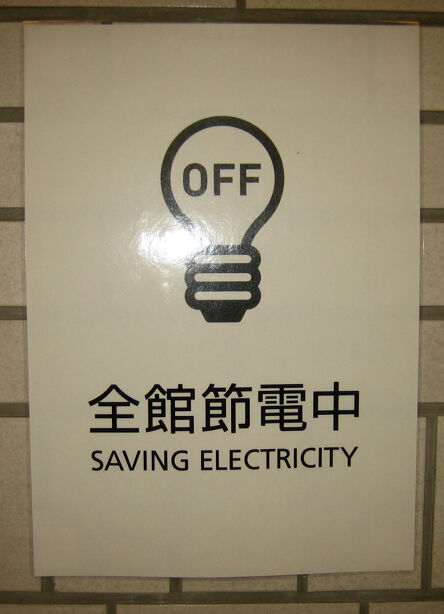
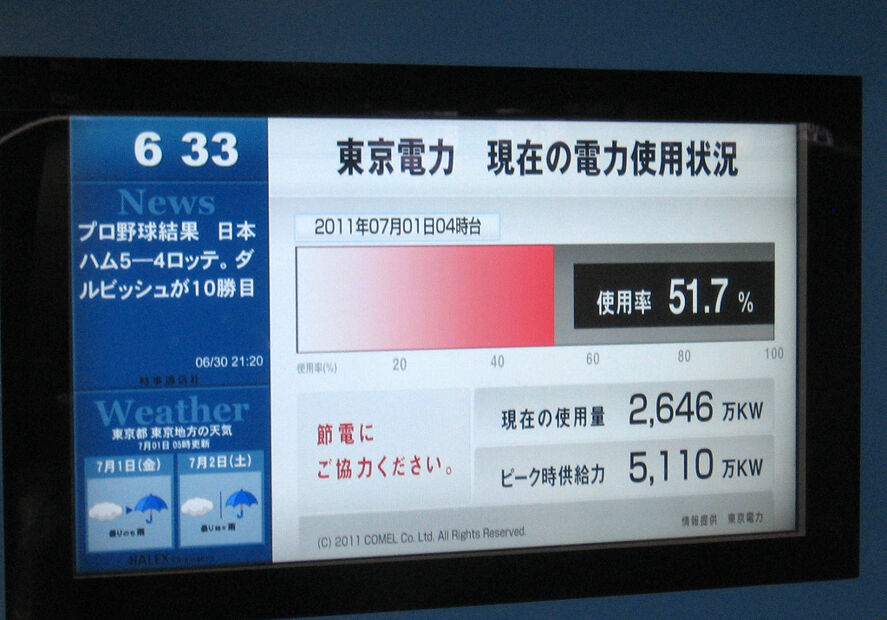
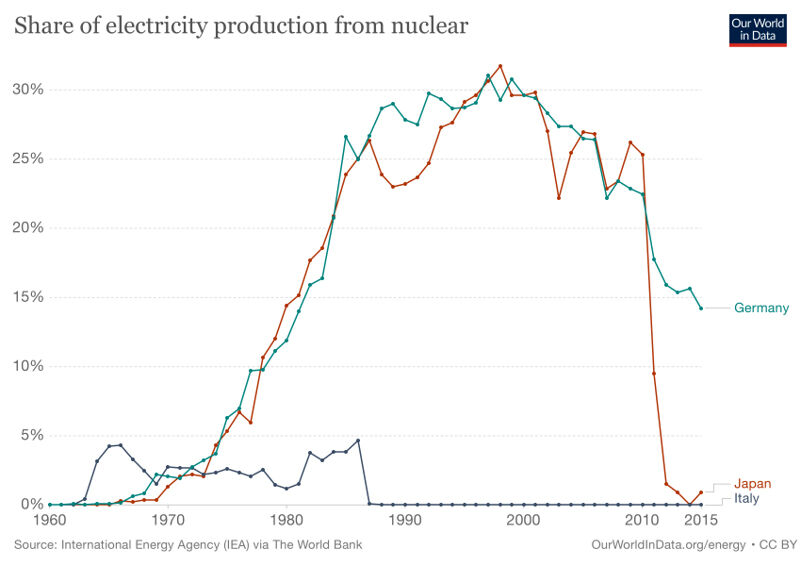
However, at that time the government of Prime Minister Naoto Kan of the Democratic Party of Japan, who after 3.11 had called for phasing out nuclear energy, was no longer in office and the conservative government of Prime Minister Shinzō Abe of the Liberal Democrats declared only the four reactors of Fukushima I “permanently” shut down. The rest remained “operational”, and after more rigid checks – based on new safety standards – established in 2013 would go back online. In 2017, the Ministry of Economy, Trade and Industry declared that, in future, 20 to 22 per cent of Japan’s energy needs should be supplied by nuclear power plants, otherwise Japan would not be able to reach the CO2 reduction goals agreed upon at the Paris climate conference in 2015 [Kidd 2018]. Current Japanese energy policy, “3E+S”, professes to be able to combine energy security, economic efficiency, environmental protection and safety.
This was – and still is – a great disappointment to all anti-nuclear groups in Japan. To return once again to the 1.10 Yasuda Auditorium memorial meeting of 2019 mentioned above, after all speeches had been delivered and the assembly began to dissolve, I had the opportunity to talk to some of the speakers. They were academics and other professionals in leading positions, but all of them had kept the spirit of 1968 alive and were still politically active. One of them told me that ever since 3.11 he had taken part every week in anti-nuclear demonstrations held on Fridays in front of the Prime Minister’s office. He was not alone. Many 1968 activists saw 3.11 as a turning point. In their view, the accident at Fukushima I had shown that nuclear energy production could not be maintained in a country as seismically vulnerable as Japan. Many people took to the streets to demonstrate (fig. 10), but to no avail.
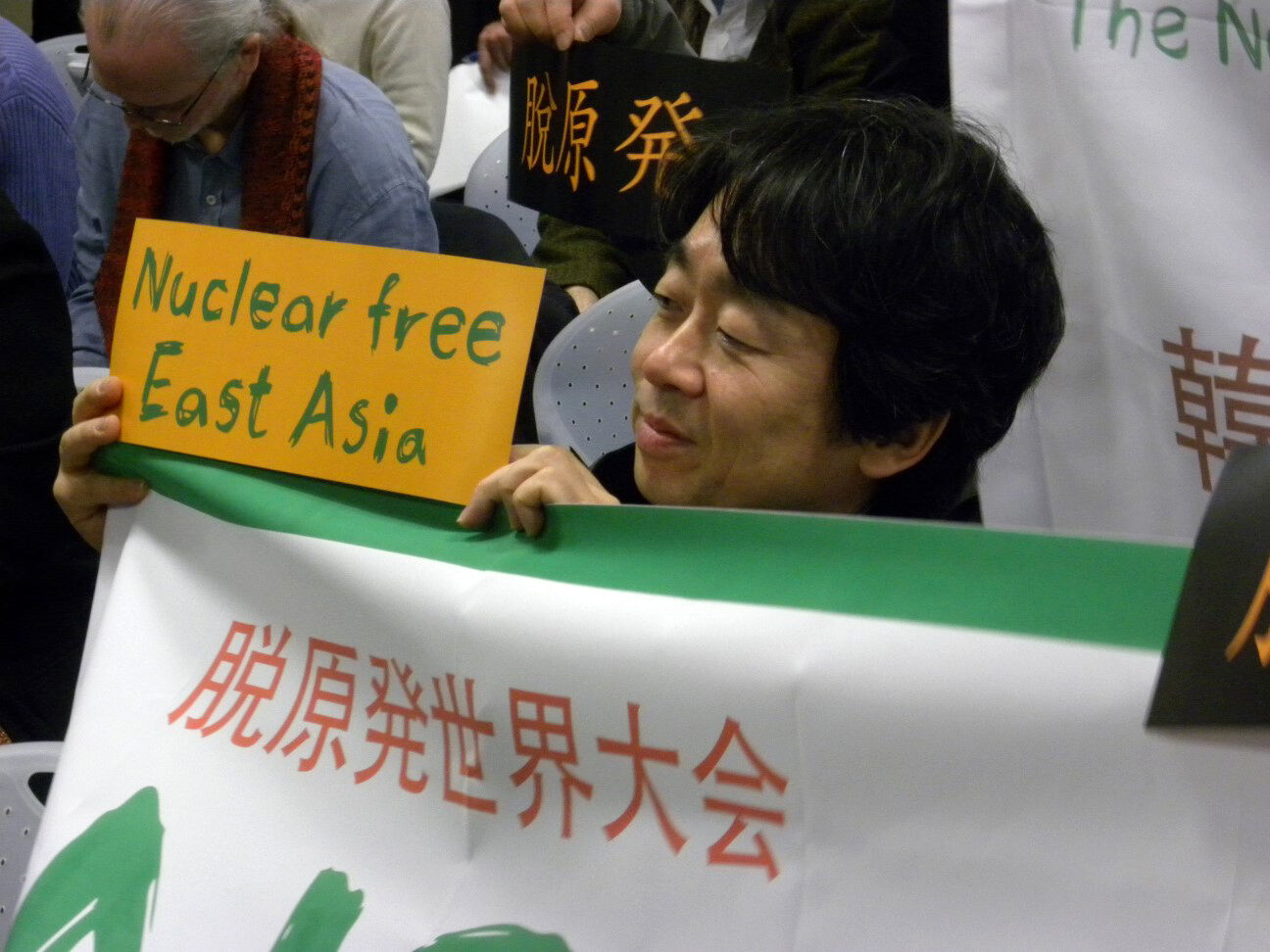
In sum, nobody denied that 3.11 was a most sever catastrophe combining a powerful earthquake with a tsunami that reached heights of up to 40.5 meters and in turn caused the total power failure at the Fukushima I nuclear power plant and the subsequent meltdown. How big is the chance – statistically – of a similar occurrence? One in a million, in ten million, in a hundred million? Maybe. Although, no one really knows, the government acts according to this kind of probabilistic reasoning and, therefore, other than upgrading safety standards did not change its nuclear policy. Should disaster prevention policies be based on probabilistic models? This is an open question with some topicality.
3.11 has strengthened the antinuclear forces in Japan, but not enough to move the government away from its pro-nuclear policy. Likewise, people living in the vicinity of nuclear power plants are unable to sway the government because they are few. City states such as Singapore aside, Japan tops the list of most highly urbanized countries. Almost all nuclear power plants are in peripheral areas, whose residents have little influence at the ballot box. Recovery after 3.11 was slow, reforms were incremental at best. Big as the event was, it did not make Japan, its economy, society, and politics, radically change course.
Happiness
Thus, most people, other than those directly affected, soon returned to the beaten track? Or do some of the consequences of 3.11 remain undetected? Psychologists are familiar with the subtler effects of traumatic experiences, Yukiko Uchida of the Kokoro Research Centre of Kyoto University, for example, who is well-known in the field of comparative happiness studies. It so happened that she conducted a nationwide online survey about the wellbeing of people 20 to 39 years old in two stages, the first in December 2010, the second in March 2011 [Uchida, Takahashi and Kawahara 2014]. The earthquake occurred shortly before the second stage. Obviously, this could not have been planned, but the temporal sequence suggested a comparison focussing on the effects of the disaster. People living in Fukushima and neighbouring prefectures were excluded from the sample of 10,744 participants of both stages. The study predicted that, for people living outside the afflicted area, the perception of well-being in life would be affected by a catastrophe of this magnitude; which the data confirmed. Survey results indicate that 3.11 had a positive effect on young people’s happiness.
Such findings require closer analysis. Uchida and her collaborators found that participants who thought of the earthquake while they responded were happier after the earthquake than before and had changed their definition of well-being. They also engaged more in prosocial behaviour than those who did not think of the earthquake. To put it bluntly, those who were thinking of the misery of others became more satisfied with their own life conditions. 3.11 had driven home the fragility of life far beyond the disaster zone.
The results […] suggest that young Japanese adults were more likely to experience attitude toward life changes after the earthquake in a positive direction by reevaluating their ordinary life and social connectedness in light of the disaster. This type of attitude change was related to increased general well-being, as is suggested in the previous literature proposing that eudaimonic well-being is related to social connectedness and meaning of life [ibid., 219].
Increased happiness after a severe disaster sounds bizarre, but the psychologists’ explanation is convincing. In the present context, the findings of this study provide one illustrative example of the unexpected repercussions of historical events. There are many others.
The centre of the world
Just one more, by way of rounding up. For spring of 2020, two events were planned relating to 3.11. In Tokyo the Japanese government would hold an anniversary memorial for the victims of the 2011 disaster, and in New York City a Review Conference of the Parties to the Treaty on the Non-Proliferation of Nuclear Weapons (NPT) was scheduled to take place at the United Nations Headquarters. On the sidelines of this conference, the Japan Confederation of A- and H-Bomb Sufferers Organizations had planned an exhibition about the dangers of nuclear weapons, in time for the 75th anniversary of the beginning of the atomic age on 6 August 1945 in Hiroshima. The Japanese government had financially supported three similar exhibitions in the past. However, when it learned that the 2020 one was to include two panels with pictures of Ukraine’s Chernobyl power plant after the 1986 accident and of post-3.11 Fukushima I, it made it known that it would halt such support unless all references to Fukushima were removed.
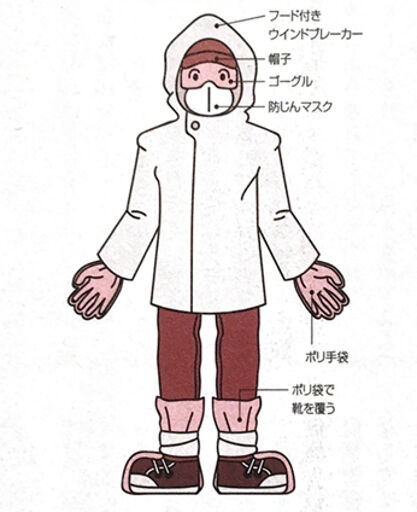
Because of its pro-nuclear policy, the Japanese government shuns any indication that there might be a connection between nuclear power generation and nuclear weapons. By pure chance it was spared from carrying out its threat of withdrawing financial support from the A-Bomb exhibit. Irony of history, the NPT Review Conference was called off, as was the 3.11 anniversary memorial service, because a previously unknown actor had entered the stage. Still beyond imagination just six months earlier, all of a sudden two serious threats to the survival of the human species were vying for attention. For a while, COVID-19 got the upper hand in New York City, the centre of the world.
Reference list
- Aoki, Masahiko, and Geoffrey Rothwell. 2013. “A comparative institutional analysis of the Fukushima nuclear disaster: Lessons and policy implications.” Energy Policy 53: 240-247. https://doi.org/10.1016/j.enpol.2012.10.058.
- Coulmas, Florian. 2008. Population Decline and Ageing in Japan – The Social Consequences. London: Routledge.
- Coulmas, Florian, and Judith Stalpers. 2011. Fukushima. Vom Erdbeben zur nuklearen Katastrophe. Munich: C.H. Beck.
- Uchida, Yukiko, Yoshiaki Takahashi, and Kentaro Kawahara. 2014. “Changes in Hedonic and Eudaimonic Well-Being After a Severe Nationwide Disaster: The Case of the Great East Japan Earthquake.” Journal of Happiness Studies 15: 207-221. https://doi.org/10.1007/s10902-013-9463-6.



 Creative Commons Attribution-NonCommercial-NoDerivatives 4.0
International License 2004- 2024
Creative Commons Attribution-NonCommercial-NoDerivatives 4.0
International License 2004- 2024
